by John Semlak | Feb 5, 2017 | #SportsHistory
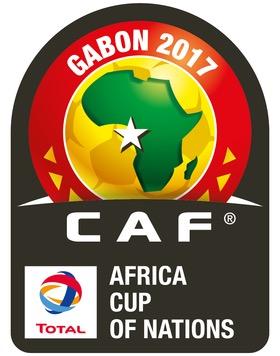
The big football game today is of course the Pharaohs vs the Indomitable Lions. The African Cup of Nations final in Libreville Gabon between Egypt and Cameroon. Egypt go for their 7th title, but Cameroon hope they can pull off another upset.See it at Legends on 33rd street across from the Empire State Building, Little Egypt on Steinway St in Astoria or Africa Kine restaurant in Harlem on 7th and 133rd.
by John Semlak | Jan 16, 2017 | #ONTHISDAY, #SportsHistory
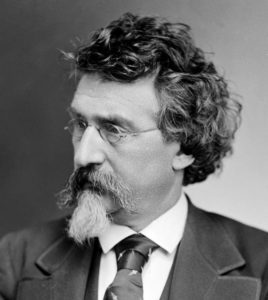 Brady in 1875
Brady in 1875
On this day in 1896, pioneering photographer Mathew Brady died. Brady was famous for his famous studio portrait of Abraham Lincoln used in the 1860 general election, as well as his photographs of the American Civil War. He and his assistant Alexander Gardner photographed Lincoln nearly two dozen times.
 Brady’s 1860 photo of Lincoln
Brady’s 1860 photo of Lincoln
In the 1850s, Mathew Brady was one of the most famous photographers in the world. In 1851 he won a medal at the Great Exhibition in London. He had studios in New York and Washington and his studio in New York was also a tourist attraction with portraits of many dignitaries from around the world. On February 27th 1860, then presidential candidate Abraham Lincoln stepped into his studio on Broadway for a photograph just before his speech at Cooper Union. This photograph was widely published during the general election campaign of 1860. Brady would move to Washington and began to document the American Civil War in photographs. Using travelling darkrooms, Brady and his assistants traveled to battlefields and took photographs of the scene.
 Brady’s grave at the Congressional Cemetery in Washington DC. The year of his death is incorrect.
Brady’s grave at the Congressional Cemetery in Washington DC. The year of his death is incorrect.
Despite his fame, Brady’s fortunes declined after the war. Anticipating future sales of his Civil War photographs, Brady invested in having photo plates made, but found far fewer buyers than anticipated. He went into debt and began to suffer from depression. He died in poverty in 1896 at Presbyterian Hospital in Manhattan. His funeral was financed by veterans of the New York 7th Infantry, and he was buried at the Congressional Cemetery in Washington DC.
by John Semlak | Dec 13, 2016 | #NYCHistory
New York has over 100 museums and collectively they contain hundreds of fabulous exhibits. Often most fascinating are the temporary exhibits. Several fantastic exhibits in New York are set to close within a month or less. Check them out before the vanish:
Alexander Hamilton: Striver, Statesman, Scoundrel at the main branch of the New York Public Library. A great exhibit that covers Hamilton’s life and features exhibits including notes from George Washington’s first Inaugural Address, which Hamilton helped Washington with. Closes December 31st.
Dinosaurs Among Us at the American Museum of Natural History. An exhibit that documents the evolution of some dinosaurs into birds. Closes January 2nd.
E Mau Ke Ea: The Sovereign Hawaiian Nation at the National Museum of the American Indian. Closes January 2nd.
Jerusalem 1000-1400: People under Heaven at the Metropolitan Museum of Art.
A superb collection that stresses Jerusalem’s cultural diversity during this period, making it a topical experience today. Closes January 8th
Who Shot Sports: A Photographic History, 1843 to the Present at the Brooklyn Museum.
A must for sports lovers–and incredible collection of sports photos. I reviewed it on my blog last week. Closes January 8th. The BM charges the full $16 adult admission to see this exhibit, though it is only $10 on the first Saturday.
The Battle of Brooklyn at the New-York Historical Society. The Exhibit documents the important Revolutionary War battle on Long Island during which George Washington is forced to abandon New York, though he preserves the Continental Army. Filled with various artifacts from the battle and the time period, including copies of the Declaration of Independence and Thomas Paine’s Common Sense. Closes January 8th.
Agnes Martin at the Guggenheim Museum. Closes January 11th
Odessa / Оде́сса: Babel, Ladyzhensky and the Soul of a City at the Yeshiva University Museum at 15 West 16th Street. This exhibit is at the top of my to-do list. Looks like a good one for Jewish interest or Slavophiles. Closes January 15th
Insecurities: Tracing Displacement and Shelter at the Museum of Modern Art. I haven’t seen this yet but it looks like a powerful take on an important social issue. Closes January 22th.
Word and Image: Martin Luther’s Reformation at the Morgan Library and Museum. 90 objects including one of six original copies of Luther’s 95 Theses. Closes January 22nd.
America to Zanzibar: Muslim Cultures Near and Far at the Children’s Museum of Manhattan. A fantastic exhibit that helps connect Muslim culture to New York and New Yorkers. Closes January 31st.
by John Semlak | Dec 7, 2016 | #NYCSports
Photographers have long been drawn to sporting events, looking to capture moments of triumph, exhilaration, struggle, passion, and also despair and defeat. The Brooklyn Museum is running an exhibit now which shows the breadth of possibilities for sports photography. The exhibition is called Who Shot Sports: A Photographic History, 1843 to Present. It’s at the Brooklyn Museum until the 8th of January.
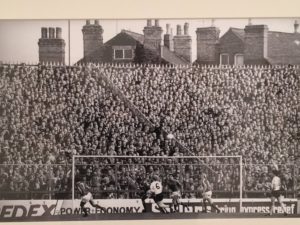
One of my favorite photos in the exhibit. It’s a photo by Gerry Cranhan of a 1979 soccer match at the City Ground between Nottingham Forest and Bolton Wanderers.
The images I’ve attached are photos of the exhibit taken by me, many which have my reflection or other blemishes. Photographs are allowed, though a few photos have a no-photography label just for that photo.
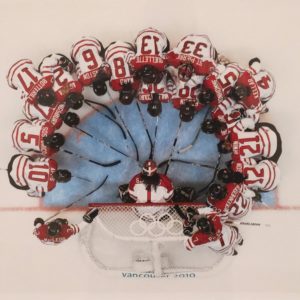
Team Canada huddling on the ice during the 2010 Winter Olympics.
The exhibition contains over 200 photos in several rooms. They depict a wide range of sporting topics and many different sports including baseball, cricket, soccer, American football, basketball, etc. Most photos are enlarged enough to view comfortably. The photos are grouped thematically, not by sport (though there is an Olympics section) but by the photo’s relationship with the fan, the photographer or athlete.
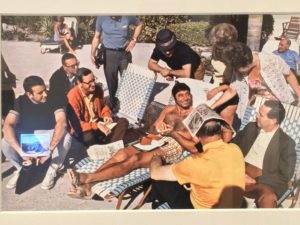
NFL star Joe Namath on vacation in Florida.
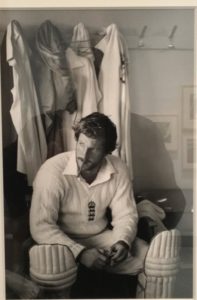
English cricketer Ian Botham
The exhibition has sections of photos of fans, photos of the field of play, photos of athletes in training, athletes off the field, and other themes. Some pictures show famous athletes like Muhammad Ali, Diego Maradona,, Carl Lewis, the cricketer Ian Botham, etc, but some feature nameless athletes such as impoverished children playing soccer barefoot. Some photos are iconic shots that you probably have seen like Ali standing over Sonny Liston or Babe Ruth facing the crowd but there are many more. Some photos are experimental, such as a photo of Muhammad Ali boxing underwater. Some photos feature unusual angles such as overhead shots.
 The Knuckleball, a 1913 photo of a baseball held by pitcher Eddie Cicotte
The Knuckleball, a 1913 photo of a baseball held by pitcher Eddie Cicotte
The exhibition takes at least an hour to appreciate fully. You are required to pay the full suggested admission of $16 for an adult; children 19 or under are free and there are discounts for students and seniors. A ticket to see the museum’s permanent exhibits only is pay as you wish. Other exhibits include a world-class Ancient Egypt collection, a reconstruction of the 17th-century Jans Schenk house, and European and American art collections with pieces by Rodin and Monet. The museum’s normal hours are 11-5, Wednesday-Sunday. On the first Saturday of each moth it’s open until 11 pm and the special exhibition is only $10. Before visiting, study the details more fully on the museum’s website.
 The Twickenham Streaker.
The Twickenham Streaker.
by John Semlak | Nov 19, 2016 | #LincolninNewYork
Seven score and 13 years ago today on November 19th 1863, Abraham Lincoln gave one of the most important speeches in modern history–the Gettysburg Address. In July that year, Union and Rebel forces had met at the battlefield in the bloodiest battle of the war. Four and a half months later, Abraham Lincoln and several members of his cabinet (including Secretary of State William Seward) gathered to consecrate the battlefield.
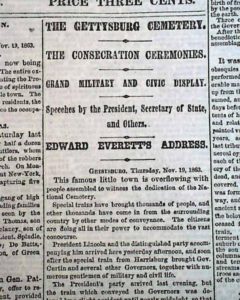 Article in the New York Tribune covering the day’s events. Lincoln’s ‘dedicatory remarks’ were preceded by a 2-hour oration by former Massachusetts governor Edward Everett.
Article in the New York Tribune covering the day’s events. Lincoln’s ‘dedicatory remarks’ were preceded by a 2-hour oration by former Massachusetts governor Edward Everett.
Lincoln’s speech was part of a full-day program of events, including a two-hour oration by former Massachusetts Governor and Secretary of State Edward Everett, who was considered by some to be the finest American orator at that time. Also a band played and a benediction was read. Lincoln was scheduled to deliver ‘dedicatory remarks’.
 Text of the speech in the New York Times.
Text of the speech in the New York Times.
Lincoln’s speech was reported in newspapers nationwide as well as across the Atlantic. Reactions at the time varied. The New York Times (a Republican-leaning paper then) reported that the speech was interrupted by applause five times and followed by ‘long and uninterrupted applause. The full speech was printed in the major New York newspapers including the Times and the New York Tribune.
There are five known copies of the speech written by Lincoln himself. One of them, the Bancroft copy, is kept at Cornell University in upstate New York. It was written for the historian George Bancroft in 1864.
 The Bancroft copy of the Gettysburg Address kept in the Carl A. Kroch Library at Cornell University.
The Bancroft copy of the Gettysburg Address kept in the Carl A. Kroch Library at Cornell University.
by John Semlak | Sep 12, 2016 | #NYCHistory
I was living abroad in Moscow, Russia when September 11th happened. I was teaching English lessons and heard bits of news from clients during the afternoon (it happened after 4 pm there). At first I was sure it was a terrible accident. Someone told me about a second plane but I assumed he had heard the same story twice or something. Then walking home my wife called me, clearly shaken, and told me that both of the Towers were completely destroyed. We had both been to WTC multiple times.
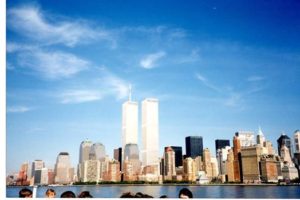 My photo of the Twin Towers in September 1998.
My photo of the Twin Towers in September 1998.
I immediately went home and glued myself to the news for hours and days, listening to NPR and the BBC via the internet. Back then I was on dial-up so I mostly depended on audio and text reports so I wasn’t exposed to the constant repeat showings of the video that many people saw.
 Flowers outside the US Embassy in Moscow
Flowers outside the US Embassy in Moscow
Via the Internet and satellite TV, September 11th was a global news event of unprecedented proportion. I can’t think of an event in my lifetime that captured the whole world like that, except perhaps the finals of World Cups. I was born after the Moon landing and JFK’s assassination. Perhaps Lennon’s death was comparable. The entire world focused on Lower Manhattan. Everyone saw the images of the aftermath so familiar now: the video of the towers falling, the debris, the mayor leading the response, the firefighters working tirelessly, etc. The French newspaper Le Monde said, “We are all Americans.” But we were all New Yorkers.
My wife and I visited NY later that year (we moved to NY permanently in 2012) and of course we saw what we could of the World Trade Center site, called Ground Zero. We saw the temporary memorial at the fence of St. Paul’s Chapel, a moving collection of flowers and photos of the victims. We saw already the ways the city had changed as a result, with so much more security. We heard stories from people who witnessed the event, including a friend who was in a neighboring building that morning and saw the second plane hit.
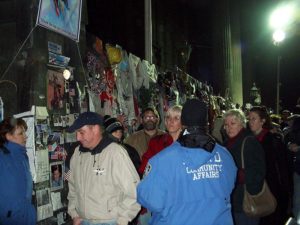 The makeshift memorial on the fence around St. Paul’s Chapel next to the World Trade Center.
The makeshift memorial on the fence around St. Paul’s Chapel next to the World Trade Center.
10 years later the 9/11 Memorial opened at the site. It continues to draw people from all over the world–four million during its first year. In 2015 the observatory at One World Trade Center opened. Nearly everyone who visits New York now visits the site. It’s a place they saw on the news, and know a great deal about. They appreciate the magnitude of such a loss of life.
For New Yorkers who lived here at the time, the relationship with the World Trade Center is much more personal and evokes powerful emotions. The site is a mass graveyard, often for friends or loved ones. New Yorkers witnessed the events with their own eyes, not on the news. They were intimately familiar with the buildings, and some went there every day. I know many people who experience powerful feelings whenever they return to Ground Zero, and some who cannot bring themselves to return.
For many New Yorkers the contrast between their visit to the 9/11 Memorial and that of the thousands of visitors there can be jarring. People are there who had little connection to the events, taking pictures, eating, posing for selfies, and otherwise acting as common tourists. Furthermore, there’s a sense that the Memorial is not for New Yorkers. To an extent that’s true perhaps. The area is designed to accommodate mass tourism. Brochures are available in over 10 languages. The area is filled with tour groups. And right next the Memorial is the One World Observatory which is an attraction with a very Disneylike feel. Moreover, the recent opening of the (rather upmarket) Westfield shopping mall adjacent to the Memorial seems rather crass to many.
 One of the pools at the 9/11 Memorial
One of the pools at the 9/11 Memorial
For people visiting New York who haven’t experienced the 9/11 Memorial, a respectful visit to the site is certainly high on the list of things to see. There are few complaints from locals or visitors about the memorial itself. The giant pools and waterfalls drown out surrounding noise to allow reflection. The sight of the names is very moving. And the site creates a huge sense of scale which communicates the magnitude of the events here. The design of the memorial accommodates crowd flows well. And it’s also very near other important historic sites and attractions including the observatory atop 1WTC, St Paul’s Chapel with George Washington’s pew inside, Trinity Church where Alexander Hamilton was buried, Wall Street, etc.
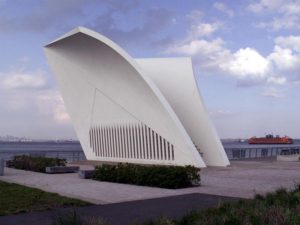
Postcards, a memorial dedicated to 274 Staten Islanders who died. The memorial is oriented towards the exact spot where the Twin Towers stood.
 A cross made from debris of the Twin Towers at the Church of the Good Shepard in Inwood, Manhattan
A cross made from debris of the Twin Towers at the Church of the Good Shepard in Inwood, Manhattan
To appreciate the events of September 11th off the beaten track, I recommend visiting one of the many other memorials dedicated to the event throughout the city and the metropolitan area. There are 9/11 Memorials throughout the five boroughs and many towns within commuting distance have memorials dedicated to the members of the community who were victims. A ferry ride away from Lower Manhattan is the ‘Postcards’ memorial dedicated to all Staten Islanders who died. At nearby Hanover Square is the Queen Elizabeth II Garden, a memorial to the 67 British victims of September 11th. In Coney Island there’s the Brooklyn wall of Remembrance. And there are countless others. Just off of Times Square is the Pride of Midtown firehouse which lost 15 firefighters on 9/11 and there’s a plaque honoring them outside.
 Memorial to 43 victims in Huntington, Long Island
Memorial to 43 victims in Huntington, Long Island
by John Semlak | Sep 10, 2016 | #NYCHistory
Public schools as well as many charter and private schools started the 2016-17 year this Thursday, ending the summer season as children return from summer camps, trips abroad or other activities to their classrooms. The first day of school is a special day in any community. In New York, it also presents an opportunity to reflect on the architecture of New York’s public schools.
Like churches (or other houses of worship), public library buildings, and other public building, schools are often neighborhood landmarks that remain as while neighborhoods change around them. Though sometimes the school moves to a new building and a new school moves in, the building itself most often remains standing, and most often as a public school. A few have been converted to other purposes, such as the MOMA PS1 in Queens, a school turned art gallery. In any case they stand is powerful anchors of a community.
School buildings built since the 1960s and 70s have been generally very modern in design and very pragmatic, on focusing on their utilitarian value to the students and educators. But in the past schools were built to be impressive landmarks, and many in fact are now protected by the Landmarks Preservation Commission.
The oldest surviving school building in the city is the 1787 Federal-style Erasmus Hall Academy in Brooklyn, which is currently not in use (the building is on the Erasmus Hall Educational Campus which is still a functioning high school). Erasmus Hall was originally a private school but absolved into the New York public school system in 1896.
Public schools in New York were built at a rapid pace during the guided age. in the 1880s-1920s. At the time New York’s population was growing rapidly due to immigrants. The public schools were seen as powerful tools to help immigrant children assimilate and shield them from poverty they often lived in. They were built as large structures with large windows (a contrast to the dark crowded tenements where many lived). A prominent example is the Al Smith school PS 1 built in the heart of the Lower East Side tenement district. In those days schools were meant to provide a respite for impoverished children. They were also meant to assimilate the children–requiring English only and forcing children to eat American-style lunches rather than ethnic immigrant fare.
During this period public schools were largely the work of the architect C P J Snyder, who was the Superintendent of School Buildings from 1891-1922. His influence on the city was immense–350 schools were built under his supervision, many which are still in use. Snyder combined beautiful architectural styles of the time such Gothic Revival, Romanesque and Neoclassical but also made them pragmatic and utilitarian buildings. Forced to build with limited budgets, Snyder included many cost saving methods such as using the same design for several schools.
by John Semlak | Aug 17, 2016 | #NYCSports
The US Olympic team in Rio currently has 11 New Yorkers. So far medals have been won by fencers Miles Chamley-Watson (Bronze–team event) and Daryl Homer (Silver, individual) as well as by swimmer Lia Neal (silver, 4X100 relay). Given it’s relative size, and the sporting prowess of its teams and clubs (Columbia University’s record college football losing streak notwithstanding), New York City perhaps has not produced the number of Olympic champions you might expect. That said, there are many legends from the past with roots in the 5 boroughs. I’ll run through my list of the most significant Olympians from New York City,–not including team sport participants or other sports like boxing and tennis where the athlete’s fame is not primarily won at the Olympics. (A good list of top basketball players from the 5 boroughs can be found here; only one from that list, Chris Mullin, even played in the Olympics. Lenny Wilkins won golds as a coach. That doesn’t include players with the New York Knicks who played at the Olympics). I’m including players with some roots in New York City, including NYC universities like Fordham and Columbia.
If I’ve missed any athletes, please feel free to tell me in the comments!!
1. Bob Beamon, from South Jamaica, Queens and Jamaica High School.
There can be no debate about the greatest Olympic moment by a New Yorker. Bob Beamon, from Jamaica High School in Queens, shattered the world record in the men’s long jump in 1968 by an amount unforeseen by the sport’s organizers. His jump was beyond the measuring equipment–one foot 9 inches or 55 cm beyond teammate Ralph Boston’s then world record. An excellent video summary of the event can be viewed here. Beamon’s jump was measured at 8 meters 90 centimeters; although Beamon wasn’t familiar with the metric system and had to be told it was 29 ft. 2½ in.
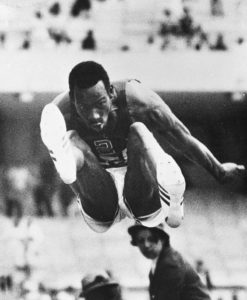 Bob Beamon’s jump in Mexico City
Bob Beamon’s jump in Mexico City
Beamon’s rise to athletic fame is remarkable given his childhood. His mother died while he was an infant. He was expelled from school once. But at Jamaica High School, he was discovered and mentored by the legendary track coach Ralph Ellis. He started to break records and won a scholarship at Western College of the University of Texas (now University of Texas at El-Paso. He didn’t graduate because he refused to compete against Brigham Young University over its racist policies. Coached unofficially by Olympian Ralph Boston, he qualified for the 1968 Olympics in Mexico City as the favorite for the long jump.

Beamon’s yearbook photo from JHS
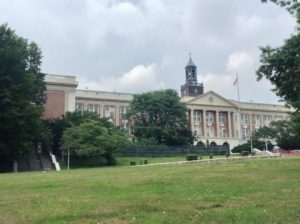
Jamaica High School in Queens
Beamon’s record lasted for 23 years, broken in Tokyo in 1991 by American Mike Powell by 5 centimeters. Carl Lewis once jumped, remarkably at the same event as Powell, one centimeter past Beamon’s record in a wind-aided jump, but that effort is not eligible for the record books. To put Beamon’s record in a different perspective–only one person has made a legal jump further than Beamon in history in official competition–48 years afterwards. In Rio, the winning jump in the men’s event was 8.38 meters, more than half a meter short of Beamon’s jump.
I would rank Beamon’s leap as the greatest athletic achievement by a New Yorkers, including baseball records by players such as Lou Gehrig, Babe Ruth or Joe DiMaggio. Their records are not tested by global competition. Also, most baseball records are arbitrary numbers only loosely connected with ultimate success in the sport. Beamon’s jump literally defined the physical limit of the human body.. Beamon’s jump is routinely cited around the world as one of the greatest athletic achievements ever and was ranked by the UK’s Guardian as the 2nd greatest ever Summer Olympic moment.
2. Al Oerter. From Astoria, Queens.
If Beamon’s jump was the greatest ever Olympic moment for a New Yorker, Al Oerter’s 4 straight gold medals from 1956-1968 in the discus throw is surely the greatest Olympic career by a New Yorker. He’s one of three Olympians to win an Olympic event 4 straight times–the others are Carl Lewis and Michael Phelps.
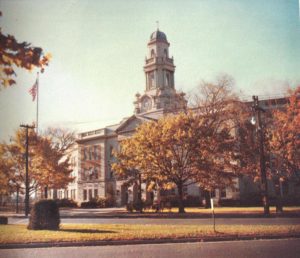
Sewanhaka High School in Floral Park, Long Island where Oerter started his track career.
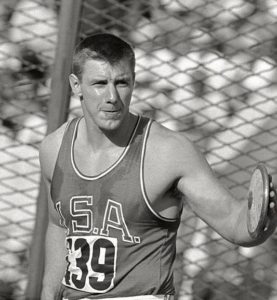
Al Oerter at the 1960 Rome games
Al Oerter was born in 1937 in Astoria, Queens but grew up just over the Nassau County border in New Hyde Park, and attended Sewanhaka High School where he competed in track. He started as a runner. The story of how he became a discus thrower is like a fairy tale. One day a discus landed at his feet in practice, and he picked it up and threw it so far he was made a discus thrower by the coach. His success earned him a scholarship at the University of Kansas, where he was a classmate of Wilt Chamberlain. He won two NCAA titles.
He first made the US Olympic team in 1956 in the Melbourne games and won his first gold with a throw of 184 feet and 11 inches, or 56.36 meters. In addition to his four consecutive golds, he set the world record 6 times, though his Olympic throws were never world records.
What’s remarkable about his 4 Olympic golds is he suffered significant injuries. In 1957 he was nearly killed in a car crash but recovered for the 1960 games. In 1964 before the Tokyo Olympics he slipped and suffered significant reb injuries on his throwing side. He was told not to compete but did anyway. He won his third straight gold playing through significant pain.
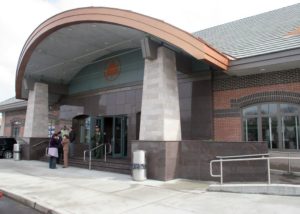
The Al Oerter Recreation Center in Flushing Meadows, Queens.
In 2009, two years after he died, the Al Oerter Recreation Center was opened in Flushing Meadows Corona Park in Queens, a tribute to one of the borough’s greatest sons.
3. Gertrude Ederle, from Manhattan.
I have to admit that by the criteria I established for this post, Gertrude Ederle is an exception. Her medal haul–1 relay gold and two individual bronzes in Paris 1924 are notable but not what made Ederle famous. She was the greatest swimmer of her time, known as the “Queen of the Waves” and the first woman to swim the English Channel.
She was born in 1905 in Hell’s Kitchen to German immigrant parents. Her father ran a butcher shop on Amsterdam Avenue, and owned a cottage in Highlands, New Jersey where she learned to swim. She joined the Woman’s Swimming Association in Manhattan, where she came under the tutelage of the WSA’s founder and pioneer of women’s swimming Charlotte Epstein and former Olympic swimmer and developer of the ‘American crawl’ style Louis Handley.
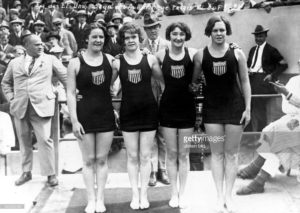
The US 4×100 relay team in Paris. Ederle is on the far right.–Getty Images
In 1922 in Brighton Beach she set seven world records and established herself as a world-famous swimmer. She traveled to the Olympics in Paris as the favorite for 3 gold medals. She got one with the 4×100 relay team which set a world record. However, during the games Ederle suffered fatigue and injury and may have not been in top form. Had she swum in a later era, almost certainly would have won more medals. In 1924 there were only 5 medal events available to female swimmers. Also, by turning professional to attract sponsors, Ederle became ineligible for future Olympics.
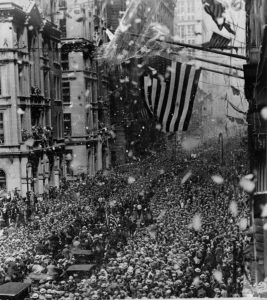
Ticker tape parade in the Financial District. It was the first ever for a female athlete.
It was after her amateur career that she really struck fame. She swam from Manhattan’s Battery Park to Sandy Hook in New Jersey in seven hours in a widely publicized race, and then turned her eyes on the English Channel, which no woman had ever swum across. She succeeded on her second attempt, crossing the Channel in 14 hours and 34 minutes, two hours faster than any man had done it. This feat catapulted her to immense fame. She was greeted by two million cheering fans at her ticker-tape parade in New York, and became one of the symbols of the Roaring Twenties. She stared in a movie, Swim, Girl, Swim, and had an unsuccessful vaudeville career.
 Ederle’s name on the Canyon of Heroes on Broadway in the Financial District
Ederle’s name on the Canyon of Heroes on Broadway in the Financial District
She suffered a back injury in 1933 that kept her in bed for 4 years, After that she lived modestly, for much of her remaining life in Flushing, Queens. She taught at the Lexington School for the Deaf for many years–Ederle herself had hearing problems most of her life. She’s buried in Woodlawn Cemetery in the Bronx. In 2013 the 59th Street Recreation Center, part of the NYC Parks Department, was renamed the Gertrude Ederle Recreation Center after a renovation. It is located several blocks from where she grew up.
 Ederle’s grave in Woodlawn Cemetary
Ederle’s grave in Woodlawn Cemetary
4. John Flanagan, from Manhattan., born in Ireland
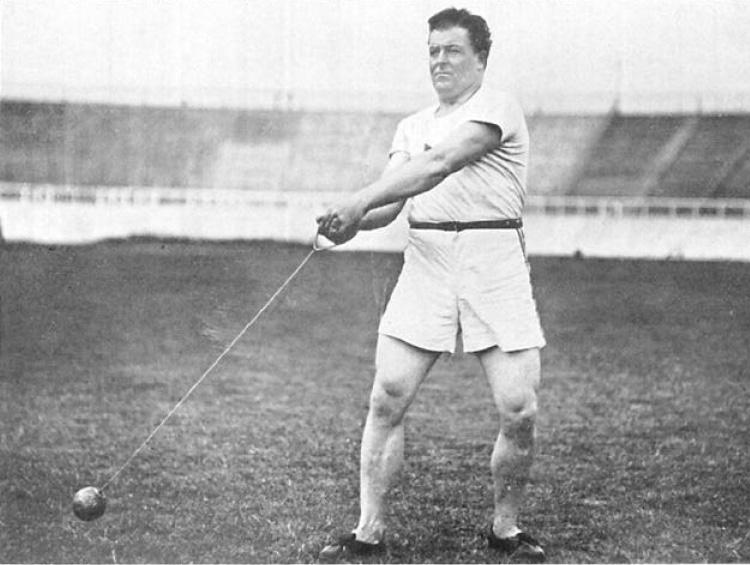 John Flanagan in the 1908 Games in London
John Flanagan in the 1908 Games in London
It’s hard to imagine now but there was a time when the Hammer Throw was an American-dominated event, or more specifically, and Irish-American event. A number of Irishmen medaled in this event in its early years (before it was dominated by the USSR).. Much of this dominance was due to the prowess of the Irish American Athletic Club (IAAC), based in Queens in today’s Sunnyside neighborhood. Though the club folded during WWI, it had a huge impact on early years of American track and field Olympic success, and produced a three-time Hammer Throw Olympic champion John Flanagan.
Flanagan was born in Country Limerick Ireland in 1873 and made the crossing to the US where be became a police officer in New York City as well as a member of the IAAC and the New York Athletic Club. He was the only non-college man to win a medal for the US in the 1900 games in Paris, where he won the first of his three consecutive gold medals in the hammer throw. In 1904 in St Louis he also won a silver in the now defunct weight throw.
 The “Irish Whales” at the 1904 Games in St. Louis. Flanagan (left), Martin Sheridan of the Irish American Athletic Club, with fellow Irishman James Mitchell of the New York Athletic Club. Flanagan and Sheridan are wearing the ‘Winged Fist’ symbol of the IAAC. Mitchell wears the Winged Sandal of the New York Athletic Club.
The “Irish Whales” at the 1904 Games in St. Louis. Flanagan (left), Martin Sheridan of the Irish American Athletic Club, with fellow Irishman James Mitchell of the New York Athletic Club. Flanagan and Sheridan are wearing the ‘Winged Fist’ symbol of the IAAC. Mitchell wears the Winged Sandal of the New York Athletic Club.
He frequently competed in competitions in the New York area, often at the IAAC’s Celtic Park facility in Queens, where the Celtic Park apartments now stand. He later returned to Ireland and coached a gold medal winning hammer thrower from Ireland, Pat O’Callaghan, who was the first non-American to win the event.
5. Ethelda Bleibtrey, from Waterford NY, grew up in Brooklyn
 Bleibtrey in Antwerp in 1920
Bleibtrey in Antwerp in 1920
Three gold medals seems like a small number for a swimmer. Well before Michael Phelps won his astronomical haul, Mark Spitz won 7 golds in 1976. But in 1920 at the Antwerp Olympics, Brooklynite Ethelda Bleibtrey won all three gold medals available to female swimmers at the time.
She was born Upstate but grew up in Brooklyn and attended Erasmus Hall High School where she took up swimming in part to heal from a back injury, and it remained a lifelong passion. She joined the Woman’s Swimming Association in Manhattan and became a favorite for medals at the 1920 Olympic Games, where she won gold at the 100 meter freestyle, the 300 meter freestyle, and the 4×100 relay. The backstroke, her strongest event, was not available for women in 1920.
 Bleibtrey (far left) with the other finalists of the 100 meter freestyle
Bleibtrey (far left) with the other finalists of the 100 meter freestyle
She would remain an advocate for women’s swimming for the rest of her life. In a stunt to promote the value of swimming for health, she once was arrested for swimming in the Central Park Reservoir (now Jackie Kennedy Onassis Reservoir).
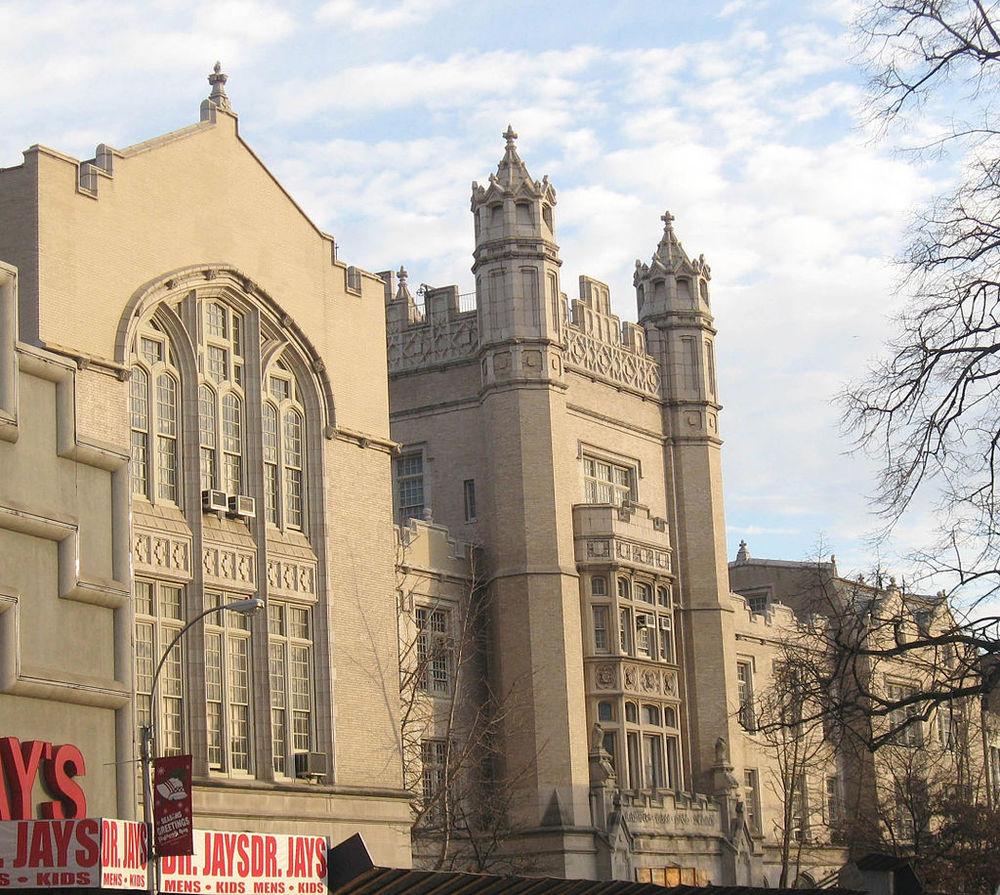 Erasmus Hall High School in Brooklyn
Erasmus Hall High School in Brooklyn
+.
by John Semlak | Jul 9, 2016 | #NYCHistory, #NYCParks, #ONTHISDAY
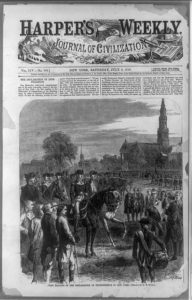
Illustration of George Washington reading the Declaration of Independence in New York on July 9th 1776. St. Paul’s Chapel, which still stands, is in the background right. The image by A.R. Waud appeared on July 9th, 1870 in Harper’s Weekly.
On July 9th 1776, George Washington read aloud the Declaration of Independence which had been read first 5 days earlier in Philadelphia. He read it in front of his troops in the area then called the Commons, where today’s City Hall Park is. The spot is commemorated with an inscription on the pavement inside City Hall Park.
 Inscription on the pavement in City Hall Park commemorating Washington’s reading of the Declaration of Independence, unfortunately faded badly.
Inscription on the pavement in City Hall Park commemorating Washington’s reading of the Declaration of Independence, unfortunately faded badly.
Inspired by Washington’s reading of the Declaration, soldiers and patriots marched down to Bowling Green Park and tore down a statue to King George III, which had been erected only six years earlier to try to improve support for the monarchy in the city. The statue was melted down and used to make bullets used by the Continental Army. Today, a fence surrounds the park what was originally installed to protect the
statue of George. It had crowns on its lampposts which were sawed off by the patriots.
 Painting by Johanes Adam Simon Oertel depicting the pulling down of the statue of King George the III at Bowling Green Park. This painting hangs at the New-York Historical Society.
Painting by Johanes Adam Simon Oertel depicting the pulling down of the statue of King George the III at Bowling Green Park. This painting hangs at the New-York Historical Society.
New York City was at the time Rebel territory but would be abandoned by Washington later that year and held by the British for the remainder of the war. Washington would return to New York at the end of the war to officially liberate the city on November 25th, 1783, when the final British troops evacuated the city.
by John Semlak | Jul 7, 2016 | #AlexanderHamilton
New York has seen a surge of interest in the life of Alexander Hamilton, of course on the back of the smash success of the Broadway Musical Hamilton. Visitors are flocking to Hamilton related sites such as his grave at Trinity Church, his home Hamilton Grange, and the Weehawken Dueling Grounds. This summer has seen the opening of two new special exhibits about Hamilton (so far) at the New York Public Library (main branch) and the New-York Historical Society.
The New-York Historical Society is always a great spot for those interested in New York’s history. Currently in their main hall they are running an exhibit called Summer of Hamilton. The exhibit is based mostly on items in the museum’s permanent collection. The highlight are the 2004 Kim Crawley statues of Alexander Hamilton and Aaron Burr each pointing pistols at each other. Also on display is a desk that Hamilton sat at to write many letters. One of my favorites is a stone plaque that was placed at the spot of the duel in 1805 by the St Andrew’s Society (Hamilton was of Scottish descent). The plaque was taken by vandals and was found in a junk store and aquired by the NYHS.
 Plaque placed at the site of the duel in Weehawken in 1805 by the St Andrew’s Society
Plaque placed at the site of the duel in Weehawken in 1805 by the St Andrew’s Society
New New-York Historical Society is located at Central Park West just south of the American Museum of Natural History, at 77th Street. The price of admission $20 for adults. It is open free of charge on Fridays from 6-8.
The New York Public Library is hosting another exhibit which is actually free of charge. It’s in the NYPL’s beautiful main branch on 5th Avenue and 42nd Street, a short walk from Times Square and Grand Central Terminal. It’s called Hamilton: Striver, Statesmen and Scoundrel. It features many documents Hamilton wrote or contributed to write, including George Washington’s farewell address which Hamilton helped write.

 Brady in 1875
Brady in 1875 Brady’s 1860 photo of Lincoln
Brady’s 1860 photo of Lincoln Brady’s grave at the Congressional Cemetery in Washington DC. The year of his death is incorrect.
Brady’s grave at the Congressional Cemetery in Washington DC. The year of his death is incorrect.



 The Knuckleball, a 1913 photo of a baseball held by pitcher Eddie Cicotte
The Knuckleball, a 1913 photo of a baseball held by pitcher Eddie Cicotte The Twickenham Streaker.
The Twickenham Streaker. Article in the New York Tribune covering the day’s events. Lincoln’s ‘dedicatory remarks’ were preceded by a 2-hour oration by former Massachusetts governor Edward Everett.
Article in the New York Tribune covering the day’s events. Lincoln’s ‘dedicatory remarks’ were preceded by a 2-hour oration by former Massachusetts governor Edward Everett. Text of the speech in the New York Times.
Text of the speech in the New York Times. The Bancroft copy of the Gettysburg Address kept in the Carl A. Kroch Library at Cornell University.
The Bancroft copy of the Gettysburg Address kept in the Carl A. Kroch Library at Cornell University. My photo of the Twin Towers in September 1998.
My photo of the Twin Towers in September 1998. Flowers outside the US Embassy in Moscow
Flowers outside the US Embassy in Moscow The makeshift memorial on the fence around St. Paul’s Chapel next to the World Trade Center.
The makeshift memorial on the fence around St. Paul’s Chapel next to the World Trade Center. One of the pools at the 9/11 Memorial
One of the pools at the 9/11 Memorial
 A cross made from debris of the Twin Towers at the Church of the Good Shepard in Inwood, Manhattan
A cross made from debris of the Twin Towers at the Church of the Good Shepard in Inwood, Manhattan Memorial to 43 victims in Huntington, Long Island
Memorial to 43 victims in Huntington, Long Island Bob Beamon’s jump in Mexico City
Bob Beamon’s jump in Mexico City






 Ederle’s name on the Canyon of Heroes on Broadway in the Financial District
Ederle’s name on the Canyon of Heroes on Broadway in the Financial District Ederle’s grave in Woodlawn Cemetary
Ederle’s grave in Woodlawn Cemetary John Flanagan in the 1908 Games in London
John Flanagan in the 1908 Games in London The “Irish Whales” at the 1904 Games in St. Louis. Flanagan (left), Martin Sheridan of the Irish American Athletic Club, with fellow Irishman James Mitchell of the New York Athletic Club. Flanagan and Sheridan are wearing the ‘Winged Fist’ symbol of the IAAC. Mitchell wears the Winged Sandal of the New York Athletic Club.
The “Irish Whales” at the 1904 Games in St. Louis. Flanagan (left), Martin Sheridan of the Irish American Athletic Club, with fellow Irishman James Mitchell of the New York Athletic Club. Flanagan and Sheridan are wearing the ‘Winged Fist’ symbol of the IAAC. Mitchell wears the Winged Sandal of the New York Athletic Club. Bleibtrey in Antwerp in 1920
Bleibtrey in Antwerp in 1920 Bleibtrey (far left) with the other finalists of the 100 meter freestyle
Bleibtrey (far left) with the other finalists of the 100 meter freestyle Erasmus Hall High School in Brooklyn
Erasmus Hall High School in Brooklyn
 Inscription on the pavement in City Hall Park commemorating Washington’s reading of the Declaration of Independence, unfortunately faded badly.
Inscription on the pavement in City Hall Park commemorating Washington’s reading of the Declaration of Independence, unfortunately faded badly. Painting by Johanes Adam Simon Oertel depicting the pulling down of the statue of King George the III at Bowling Green Park. This painting hangs at the New-York Historical Society.
Painting by Johanes Adam Simon Oertel depicting the pulling down of the statue of King George the III at Bowling Green Park. This painting hangs at the New-York Historical Society. Plaque placed at the site of the duel in Weehawken in 1805 by the St Andrew’s Society
Plaque placed at the site of the duel in Weehawken in 1805 by the St Andrew’s Society